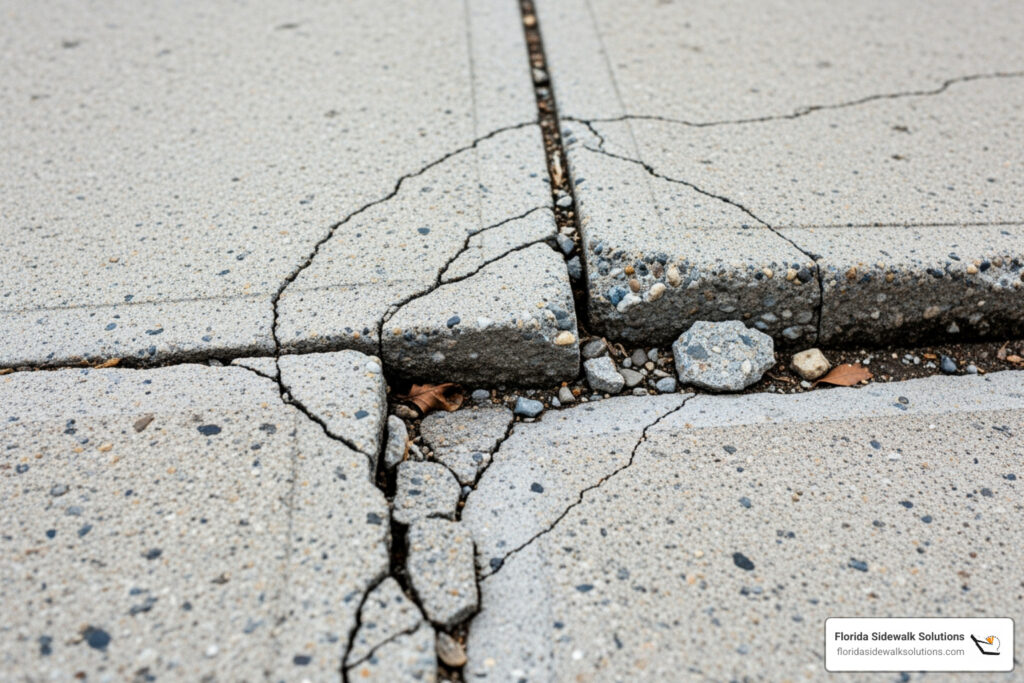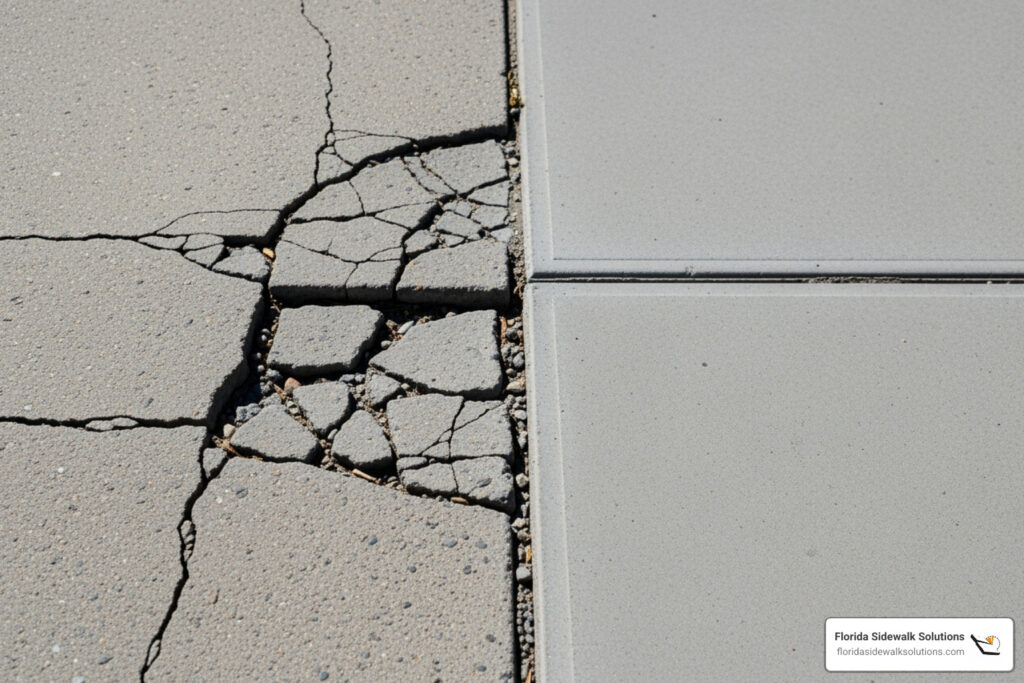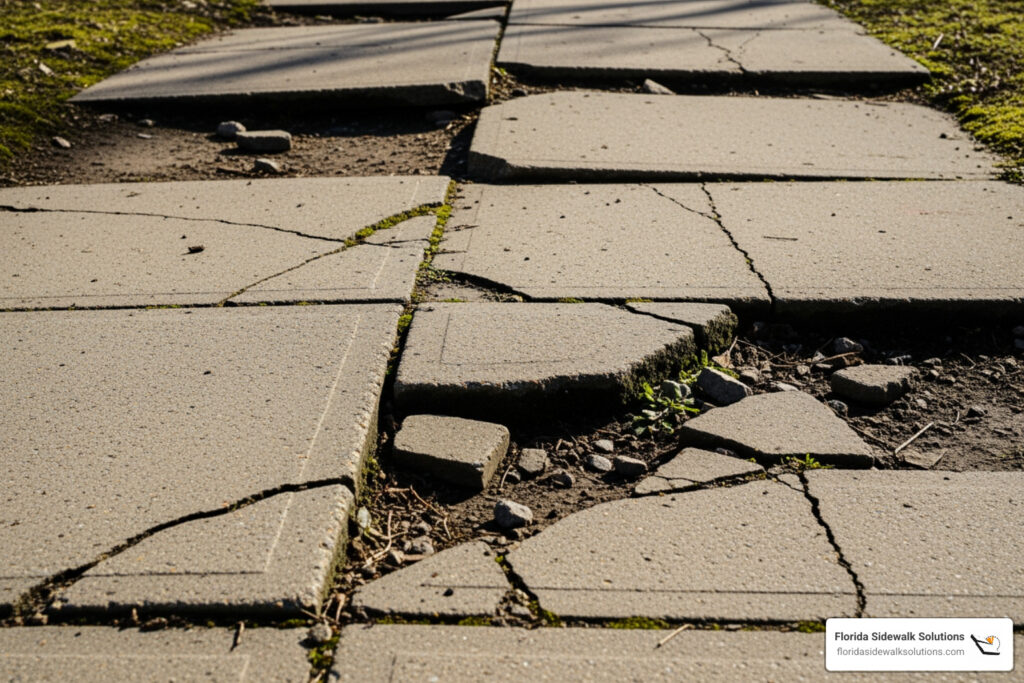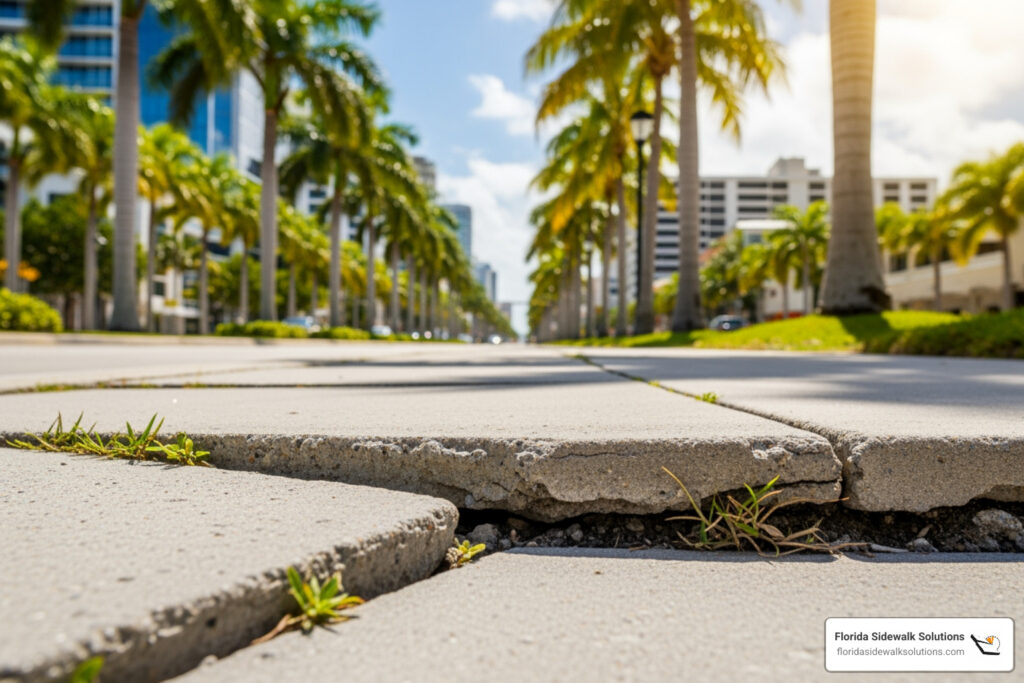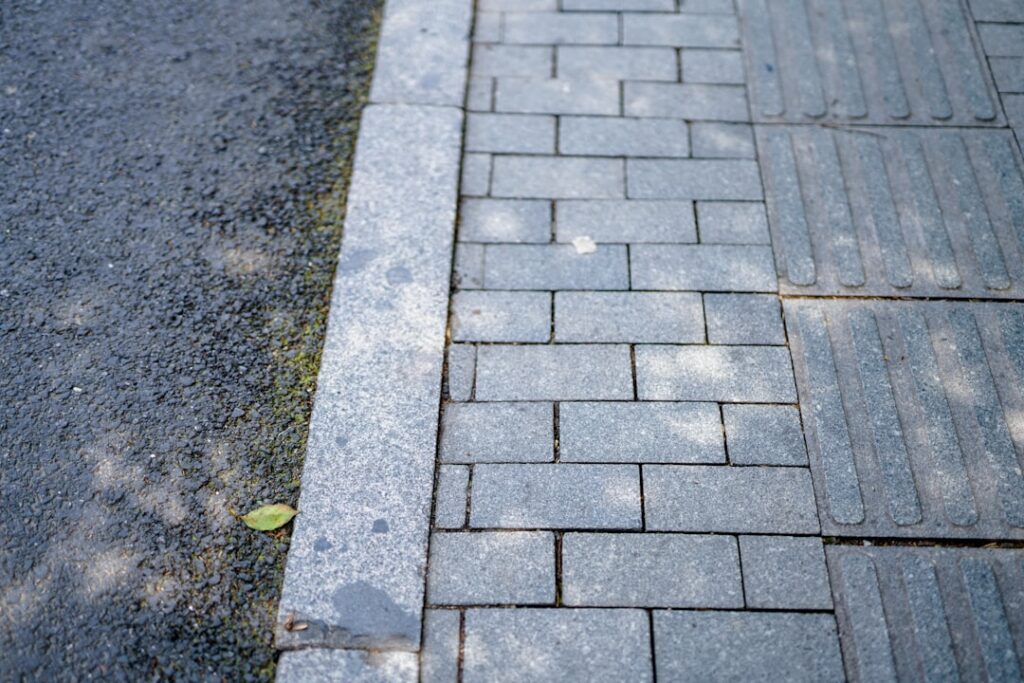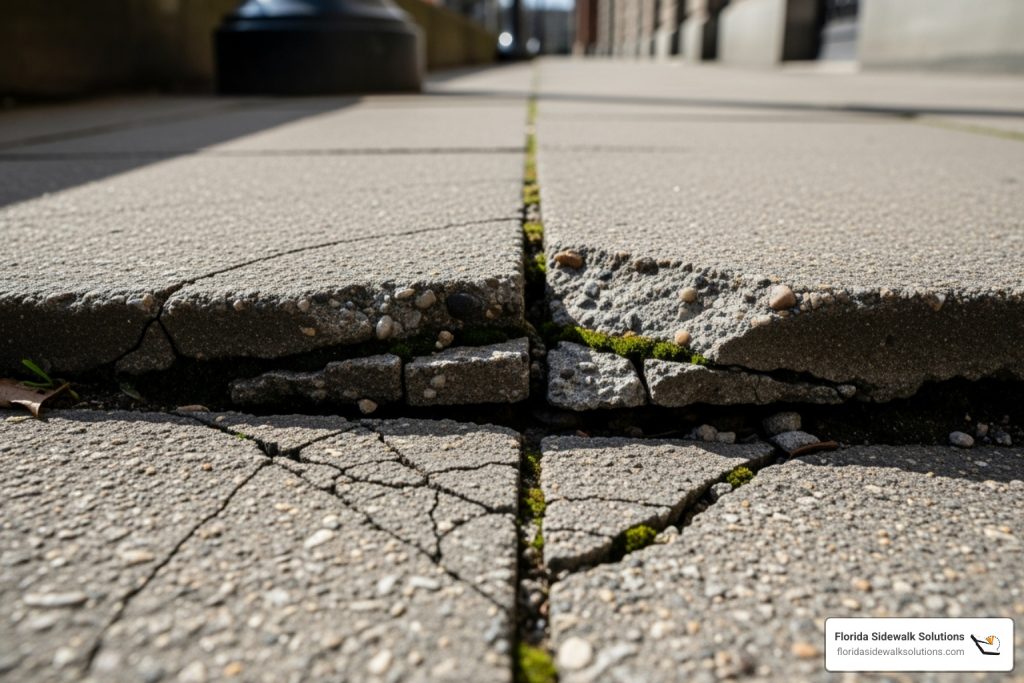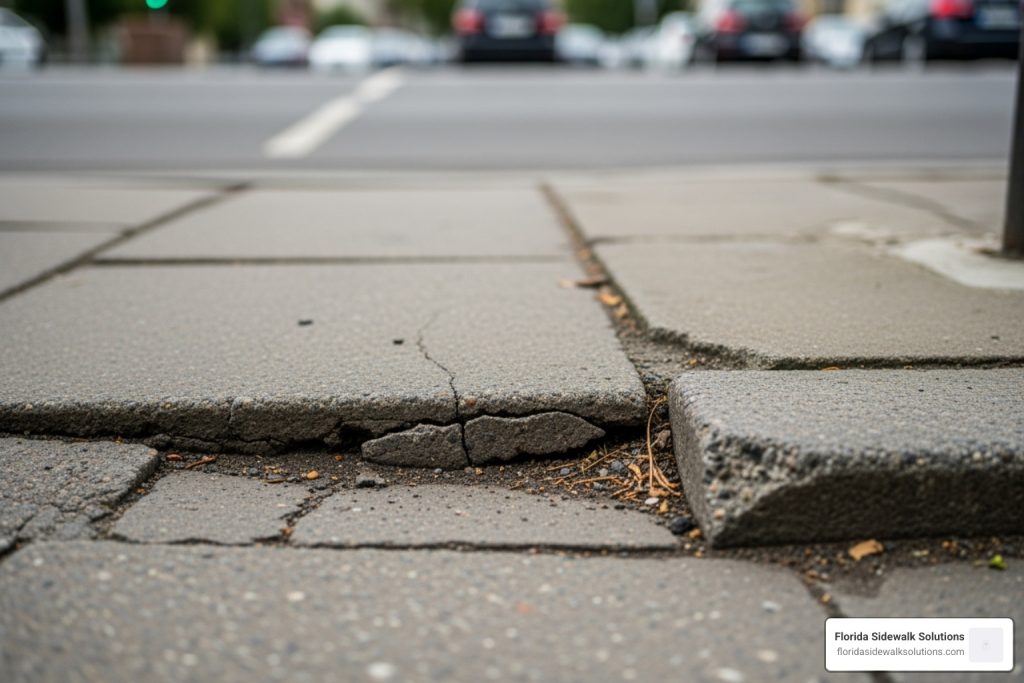Why Cracked Sidewalks Are More Than Just an Eyesore
Fix cracked sidewalk issues before they become dangerous trip hazards and costly liability problems. Whether you’re dealing with hairline cracks or uneven slabs that violate ADA compliance standards, understanding your repair options is crucial for maintaining safe pedestrian pathways.
Quick Answer: How to Fix a Cracked Sidewalk
- Minor cracks (< 1/4 inch): Clean thoroughly, fill with flexible concrete caulk, smooth, and cure.
- Wide cracks (> 1/4 inch): Use backer rod and concrete patching compound for deeper repairs.
- Uneven slabs (trip hazards > 1/4 inch): Requires professional precision concrete cutting or grinding to restore a level surface.
- Full replacement: Needed when damage exceeds 50% of a panel or structural issues exist.
Cracked and uneven sidewalks are serious safety hazards and legal liabilities for property owners. Repairing small cracks can be inexpensive, but replacing an entire sidewalk slab can cost over $1,300. More importantly, uneven sidewalks cause thousands of trip-and-fall accidents annually, exposing municipalities and property owners to significant legal and financial risks.
The causes are numerous: tree roots, soil settlement, weather cycles, and heavy traffic. Left unaddressed, cracks allow water infiltration that accelerates deterioration and creates dangerous walking surfaces.
For property and municipal managers, the challenge is to repair hazardous sidewalks efficiently while staying within budget and maintaining ADA compliance. Traditional removal and replacement are expensive and disruptive. This guide covers modern precision concrete cutting methods that eliminate trip hazards at a fraction of traditional costs—often just 1/10 the price of removal and replacement.
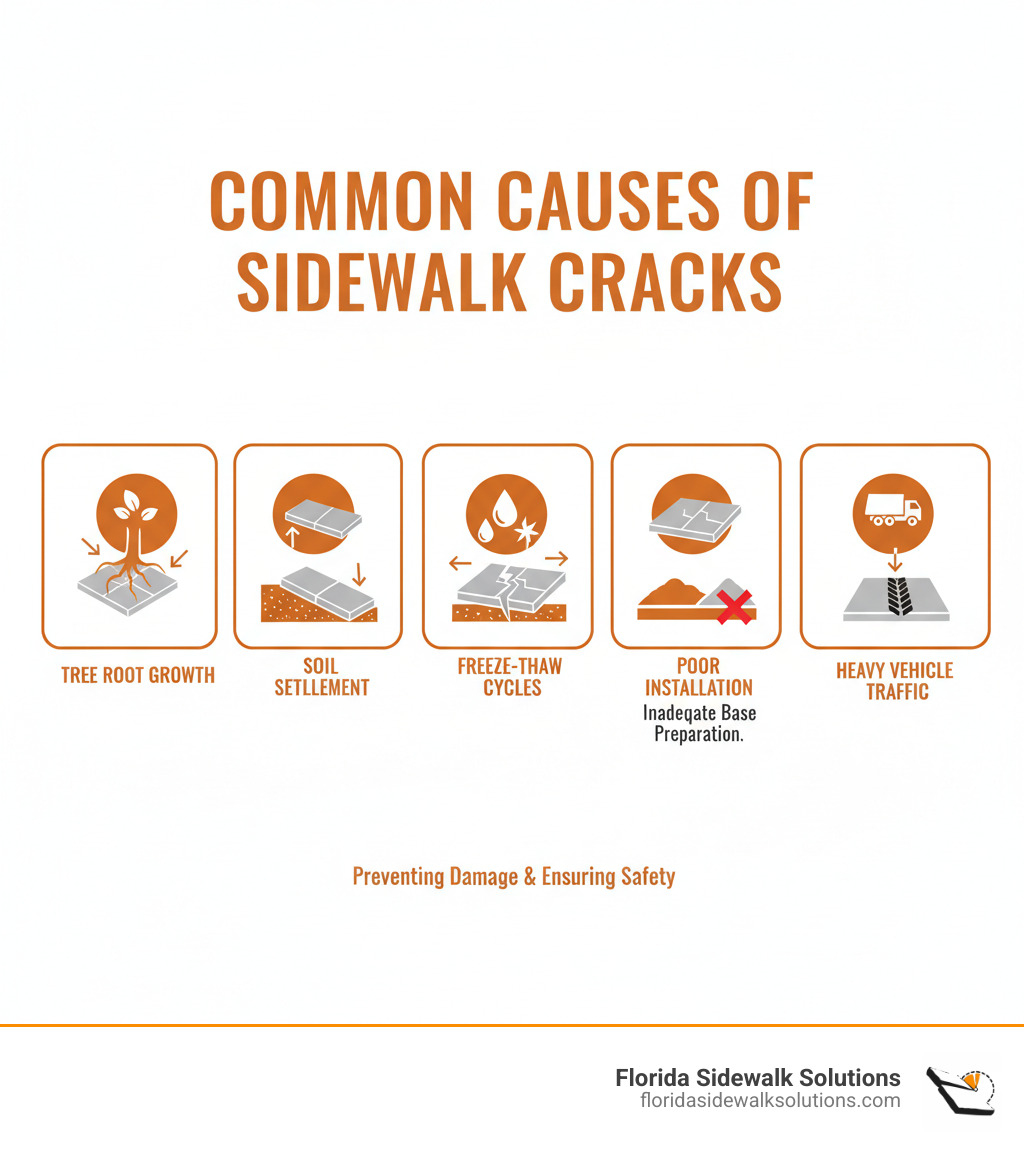
Why Sidewalks Crack and Why It Matters
Even the toughest concrete sidewalks face challenges, especially in Florida’s climate. Understanding why cracks appear is the first step toward knowing when you need to fix cracked sidewalk problems before they become serious hazards.
Common Causes of Cracks
- Tree Roots: In Florida, powerful tree roots searching for water are a primary cause of uplifted and cracked sidewalk slabs.
- Soil Settlement: The ground beneath sidewalks can shift and settle unevenly, creating voids that lead to cracking and sinking.
- Poor Initial Installation: An inadequate base, a weak concrete mix, or improper soil compaction during installation can cause premature failure.
- Heavy Vehicle Traffic: Sidewalks aren’t designed for heavy vehicles; delivery or maintenance trucks can cause stress fractures.
- Water Intrusion: Water seeping into cracks erodes the sub-base, leading to further settlement and deterioration.
The Consequences of Neglect
Ignoring cracks can be dangerous and expensive. The biggest risk is trip and fall liability. A height difference of just a quarter-inch can cause a fall, leading to serious injuries and lawsuits. The Dangers of Neglecting Sidewalk Crack Repair are significant, especially regarding ADA compliance.
Cracks also create a cycle of water intrusion and erosion, worsening the problem and increasing eventual repair costs. Finally, a cracked, uneven sidewalk hurts your curb appeal and can lower property value.
Signs Your Sidewalk Needs Attention
- Visible Cracks: Hairline cracks are entry points for water, while wider cracks signal more significant issues.
- Uneven or Sunken Slabs: Any height difference between slabs is a red flag for a trip hazard and underlying structural problems. These Sidewalk Cracks and Breaks are a major liability.
- Spalling or Crumbling Concrete: A flaking or pitting surface indicates the concrete itself is deteriorating.
- Water Pooling: Puddles that linger after rain point to poor drainage or depressions in the concrete.
- Weeds in Cracks: Plant growth indicates cracks are deep enough to hold soil and moisture, and the roots will widen them further.
Understanding Your Responsibility as a Property Owner
In most Florida municipalities, including Davie, Fort Lauderdale, and Miami, the adjacent property owner is legally responsible for maintaining the sidewalk. This obligation is in place to keep pedestrians safe, and failure to make necessary repairs can result in liability for any injuries.
Before starting any work, check with your local city or county public works department and your HOA, if applicable. They can provide information on permits, approved repair methods, and any cost-sharing programs available in your area.
Assessing the Damage: When to Call a Professional
Not every crack requires a professional, but it’s crucial to know the difference between a simple DIY fix and a job for experts to avoid liability.
-
DIY Fixes (Cosmetic Issues): Hairline cracks (less than 1/8 inch) and minor cracks (up to 1/4 inch) are often cosmetic. They can be sealed with concrete caulk or a patching compound to prevent water intrusion. These DIY repairs are temporary and do not address underlying structural problems.
-
Professional Repair (Safety Hazards): You need a professional when you have uneven slabs creating a trip hazard. A height difference of 1/4 inch or more is a violation of ADA compliance and a serious legal risk (see the ADA Standards for Accessible Design, Section 303: Changes in Level). You should also call a professional for:
- Wide, deep, or structural cracks that extend through the slab.
- Extensive spalling (crumbling surface) or missing chunks of concrete.
When a Simple Patch is Not Enough
Patching an uneven sidewalk is like putting a bandage on a broken bone—it doesn’t fix the problem. No amount of filler can level an uneven slab or correct the height difference that causes trips. These situations require specialized equipment to resolve properly and restore safety. Attempting to fix a trip hazard with a patch is a temporary cosmetic fix that leaves you liable for accidents. For these issues, you need a Cracked Sidewalk Repair Company.
Cost Considerations
While a DIY patch might cost under $100, it doesn’t solve a trip hazard. The alternative, full sidewalk slab replacement, can average over $1,300 per slab (source: HomeAdvisor). This is where professional trip hazard removal offers significant value. Our precision concrete cutting method is a permanent, ADA-compliant solution that typically costs just 1/10 the price of replacement, making it the most cost-effective choice for eliminating safety hazards.
How to Address Minor Cracks (Temporary DIY Method)
For small, non-structural cracks that are not trip hazards, a DIY repair can be a reasonable temporary solution to prevent water intrusion and improve appearance. This method will not fix cracked sidewalk sections that are uneven or sunken.
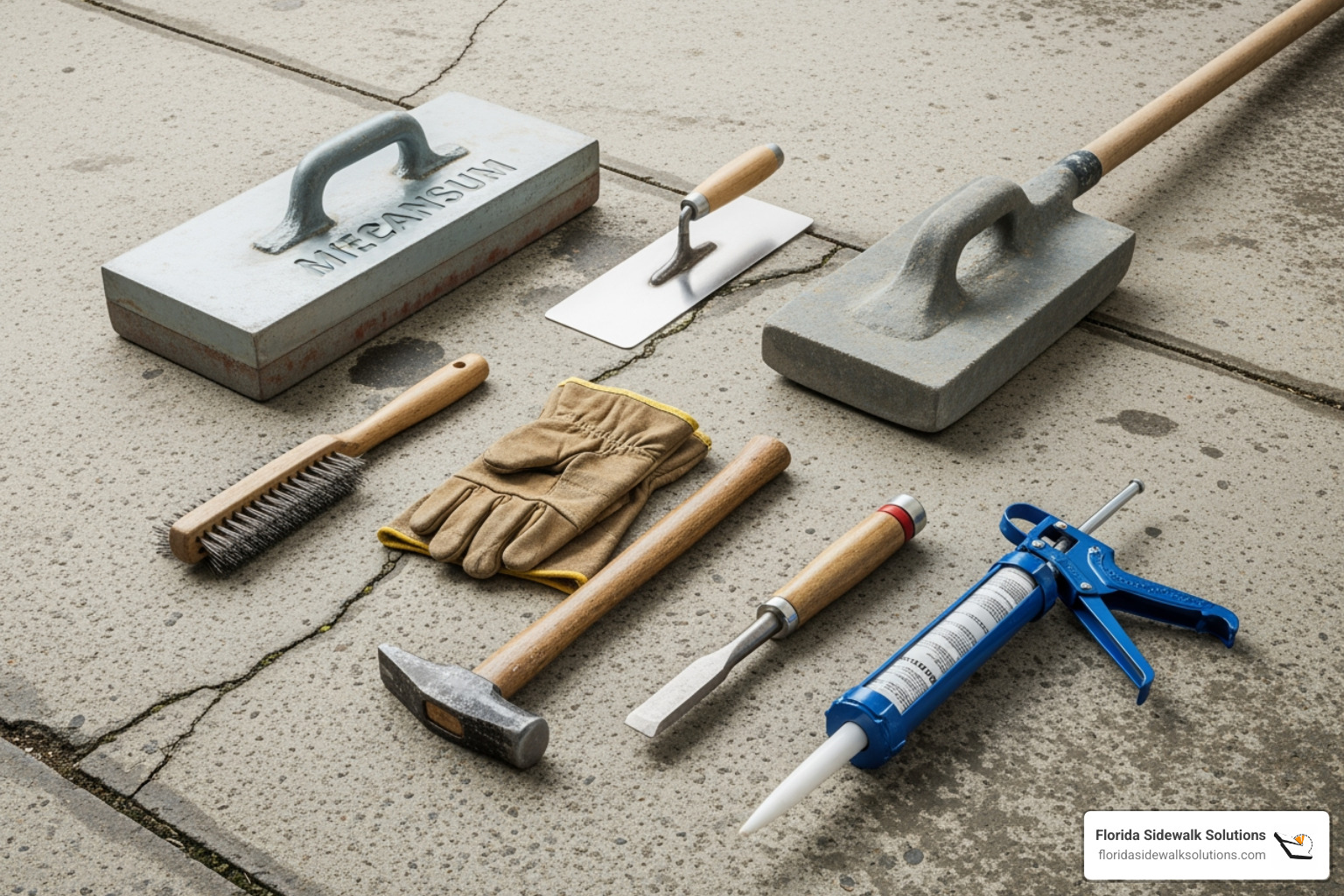
Before starting, gather your tools: a wire brush, trowel, concrete caulk or patching compound, safety glasses, and gloves.
Safety Precautions
Always wear sturdy work gloves and safety glasses. Concrete dust and repair materials can be irritants, so protecting your hands and eyes is essential.
Step 1: Prepare and Clean the Crack
Proper preparation is critical for a lasting patch. The repair material needs a clean, solid surface to bond with.
- Clean the Crack: Use a stiff wire brush or chisel to remove all loose debris, dirt, and vegetation from inside the crack.
- Wash and Dry: For a deeper clean, use a pressure washer. Afterward, ensure the crack is completely dry before proceeding, which may take 24 hours or more in Florida’s humidity.
For more insights on identifying which Sidewalk Cracks need attention, we’ve got you covered.
Step 2: Filling Different Types of Cracks
The width of the crack determines the material you should use.
- Narrow Cracks (< 1/4 inch): Use a flexible, polyurethane-based concrete caulk. Apply a steady bead to fill the crack completely.
- Wider Cracks (> 1/4 inch): Use a concrete patching compound. For deep cracks, first insert a foam backer rod about 1/2 inch below the surface. This saves material and creates a more durable repair. Apply the patching compound over the backer rod.
For more detailed techniques, check out our guide on Fixing Sidewalk Cracks.
Step 3: Finishing and Curing the Repair
- Smooth the Patch: While the material is still wet, use a trowel or putty knife to smooth the surface flush with the surrounding concrete.
- Cure Properly: Allow the repair to cure according to the manufacturer’s instructions. Avoid walking on the area for at least 24 hours.
- Dispose of Waste: Leftover wet concrete must be solidified before disposal according to local regulations.
Why Professional Trip Hazard Repair is the Best Solution
While DIY fixes have their place, they are ineffective and inappropriate for uneven sidewalks. When safety and ADA compliance are on the line, professional repair is the only responsible choice.
Limitations of DIY Fixes
Filling a crack does not fix a trip hazard. A patch or filler cannot correct the height difference between two uneven slabs, which is the actual cause of trips and falls. These cosmetic fixes ignore the underlying structural problems—like tree roots or soil settlement—and leave the property owner exposed to liability. Attempting to patch a trip hazard is a temporary solution that fails to address the real danger. For real solutions to Fixing Sidewalk Cracks Forming Trip Hazards, you need professional assessment and repair.
Signs You Need an Expert
It’s time to call a professional when you see any of the following:
- Uneven Slabs: A vertical height difference of 1/4 inch or more between sidewalk sections is an official trip hazard that requires professional repair.
- Large or Structural Cracks: Deep cracks that run through the entire slab indicate serious underlying issues that a patch cannot solve.
- Widespread Damage: If multiple sections of your sidewalk are damaged, it points to a systemic problem that needs a comprehensive, professional solution.
- ADA Compliance Requirements: Public and many private walkways must meet ADA standards. Only professional repair can guarantee compliance and protect you from legal and financial liabilities.
The Florida Sidewalk Solutions Method: Precision Concrete Cutting
When dealing with a dangerous trip hazard, you need a permanent solution that is both effective and affordable. At Florida Sidewalk Solutions, we provide just that to communities throughout Florida, including Davie, Fort Lauderdale, Coral Springs, Boca Raton, West Palm Beach, Miami, and Fort Myers.
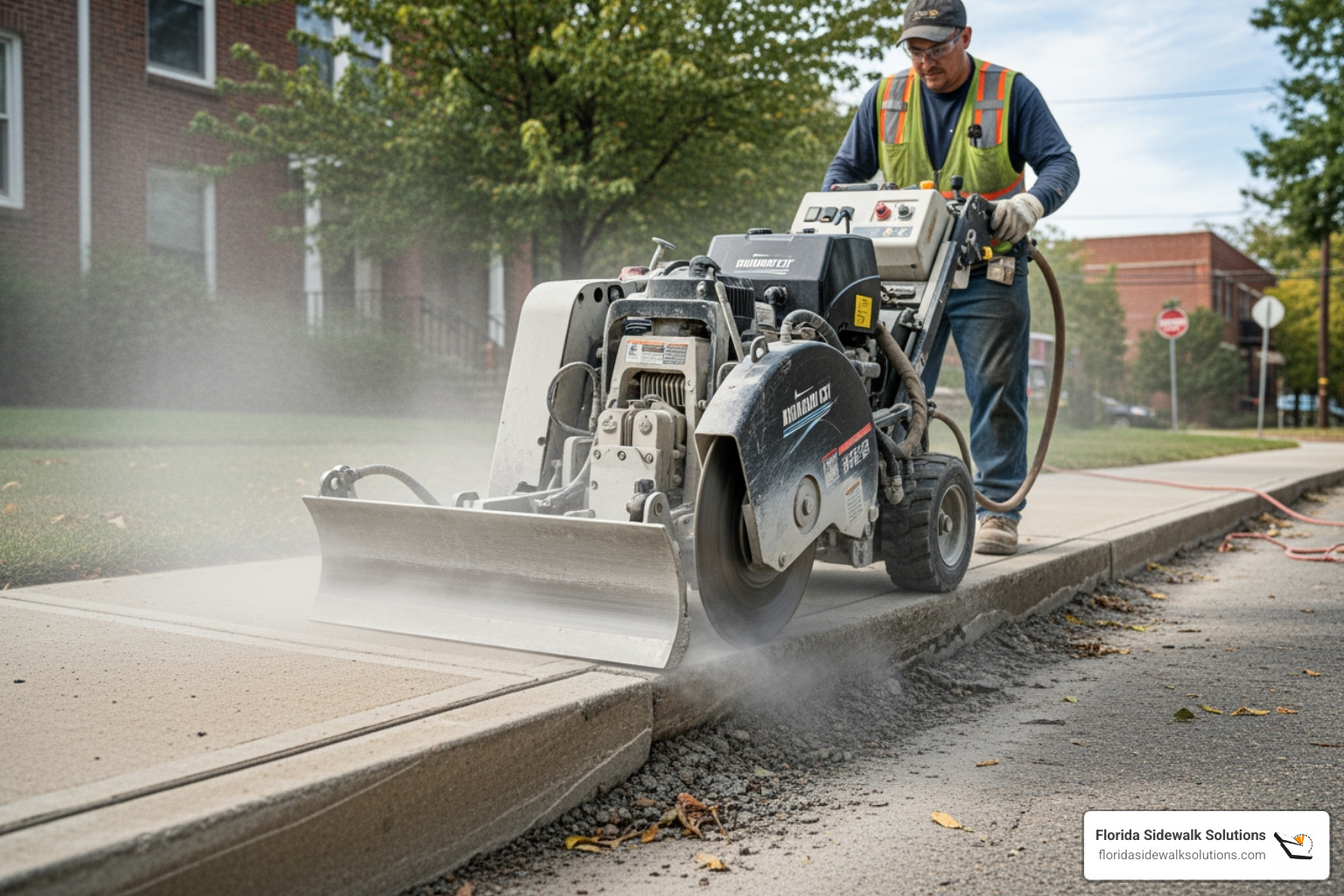
How Precision Concrete Cutting Works
Instead of relying on outdated methods, we use our own patented precision cutting technology. This approach allows us to make precise, angled cuts to the raised concrete slab, removing the height difference and creating a smooth, level transition. We don’t just mask the problem—we eliminate the trip hazard at its source by restoring the sidewalk to a perfectly level surface.
Why This Method is More Effective and Less Expensive
The Florida Sidewalk Solutions method of cutting concrete is more effective and less expensive than conventional scabblers, concrete grinders, or removal and replacement. Our approach typically costs just 1/10 of what you’d pay for traditional replacement, offering a permanent solution without the enormous bill.
Our process is also far more efficient, minimizing disruption to your property. Key benefits include:
- No Dust and Less Noise: Unlike messy grinding, our method is clean and quiet, making it ideal for any property.
- A Permanent, ADA-Compliant Fix: The repair is not a temporary patch. It’s a permanent, durable solution that meets all ADA compliance standards for trip hazards.
For more details on our approach to Concrete Sidewalk Crack Repair, you’ll see why property managers across Florida trust us.
How This Method Restores Safety and Curb Appeal
By eliminating trip hazards, we drastically reduce your liability exposure and create genuinely safe walking surfaces for everyone, from elderly residents to children. This is critical for meeting legal ADA requirements.
Beyond safety, a professionally repaired sidewalk improves your property’s curb appeal. Smooth, level concrete signals that a property is well-maintained, making a positive first impression on visitors, residents, or customers.
Choosing the Right Sidewalk Crack Repair Service
Choosing the right professional partner is critical to permanently solving your sidewalk trip hazards. It’s not just about finding someone to fix cracked sidewalk issues—it’s about finding a specialist with the right technology and expertise.
What to Look for in a Contractor
When evaluating contractors, use this checklist to ensure you hire a true professional:
- Specialization: Look for a company that focuses specifically on trip hazard removal. A general concrete contractor may not have the specialized equipment or understanding of ADA compliance that a specialist does.
- Licensing and Insurance: Verify that the contractor is fully licensed to work in Florida and carries comprehensive liability insurance. This protects you from liability during the repair process.
- Local Experience: Choose a company with a proven track record in your area. At Florida Sidewalk Solutions, we have years of experience serving communities like Davie, Fort Lauderdale, and West Palm Beach, so we understand the local soil and climate conditions. You can learn more about our specialized Sidewalk Crack Repair Service.
- References and Past Work: Ask for client references or a portfolio of completed projects. A reputable company will be proud to share examples of their work.
- Technology and Methods: Ask how they plan to fix the trip hazard. Be wary of contractors who default to expensive full replacement or dusty, outdated grinding methods. A modern contractor should be able to explain their technology, like our patented precision concrete cutting, which provides a superior, more cost-effective result.
Preventing Future Cracks and Ensuring Long-Term Safety
After your sidewalk is repaired, proactive maintenance can protect your investment and prevent future problems. These simple strategies can help keep your walkways safe for years to come.
The Role of Concrete Sealing
Concrete is porous and can absorb water, which leads to deterioration. Applying a quality concrete sealant creates an invisible barrier that protects against water and UV damage. Sealing is especially important after a repair to protect the new work and surrounding concrete. In Florida’s climate, sealant should typically be reapplied every two to three years to prevent a Cracking Sidewalk from getting worse.
Proper Drainage
Poor drainage is a leading cause of sidewalk failure. Water pooling near or under a sidewalk softens the soil base, leading to settlement and cracking.
- Ensure your gutter downspouts discharge water at least three to four feet away from sidewalks.
- Check that the ground next to your sidewalk slopes gently away from the concrete to allow water to run off.
Managing Tree Roots
Tree roots are a powerful force against concrete. To manage them:
- Install Root Barriers: For existing trees, professionally installed underground barriers can redirect root growth away from sidewalks.
- Plant Smart: When planting new trees, choose species with less aggressive root systems and plant them a safe distance from concrete surfaces.
Simply grinding a sidewalk lifted by roots is a temporary fix; the roots will continue to grow and lift the slab again.
Checking Local Regulations
Before undertaking any major sidewalk work, check with your local municipality (such as Coral Springs, Boca Raton, or Miami) or HOA. They have specific ordinances regarding permits, repair standards, and property owner responsibility. When you work with a professional service like ours, we handle the permitting process to ensure all work is fully compliant with local codes and ADA standards.
Conclusion
We’ve covered the essential steps to fix cracked sidewalk issues, from minor cosmetic fixes to serious trip hazards. The most important takeaway is knowing when to DIY and when to call a professional.
Minor, hairline cracks can often be addressed with a temporary DIY repair to keep water out. However, when you’re facing uneven slabs, trip hazards with a height difference of 1/4 inch or more, or deep structural cracks, professional intervention is essential for ensuring safety and ADA compliance.
At Florida Sidewalk Solutions, our patented precision concrete cutting method was designed specifically for these serious trip hazards. It offers a permanent, ADA-compliant solution at roughly one-tenth the cost of traditional removal and replacement, all without the dust, noise, and disruption of older methods.
A small crack ignored today can become a major liability tomorrow. Don’t wait for a trip-and-fall accident to happen. Protect your property and the people who use your walkways.
For a permanent and affordable solution to your sidewalk trip hazards, trust the experts who have made safety their specialty. Get a free quote for your affordable sidewalk repair today! Let’s make your sidewalks safe, compliant, and worry-free.


